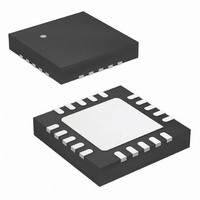ATTINY24-15MZ Atmel, ATTINY24-15MZ Datasheet - Page 96

ATTINY24-15MZ
Manufacturer Part Number
ATTINY24-15MZ
Description
MCU AVR 2K FLASH 15MHZ 20-QFN
Manufacturer
Atmel
Series
AVR® ATtinyr
Datasheet
1.ATTINY24-15MZ.pdf
(225 pages)
Specifications of ATTINY24-15MZ
Package / Case
20-QFN Exposed Pad
Voltage - Supply (vcc/vdd)
2.7 V ~ 5.5 V
Operating Temperature
-40°C ~ 125°C
Speed
16MHz
Number Of I /o
12
Eeprom Size
128 x 8
Core Processor
AVR
Program Memory Type
FLASH
Ram Size
128 x 8
Program Memory Size
2KB (2K x 8)
Data Converters
A/D 8x10b
Oscillator Type
Internal
Peripherals
Brown-out Detect/Reset, POR, PWM, WDT
Connectivity
USI
Core Size
8-Bit
Cpu Family
ATtiny
Device Core
AVR
Device Core Size
8b
Frequency (max)
16MHz
Interface Type
SPI/UART
Total Internal Ram Size
128Byte
# I/os (max)
12
Number Of Timers - General Purpose
2
Operating Supply Voltage (typ)
3.3/5V
Operating Supply Voltage (max)
5.5V
Operating Supply Voltage (min)
2.7V
On-chip Adc
8-chx10-bit
Instruction Set Architecture
RISC
Operating Temp Range
-40C to 125C
Operating Temperature Classification
Automotive
Mounting
Surface Mount
Pin Count
20
Package Type
QFN EP
Lead Free Status / RoHS Status
Lead free / RoHS Compliant
- Current page: 96 of 225
- Download datasheet (4Mb)
14.5
96
Counter Unit
Atmel ATtiny24/44/84 [Preliminary]
The main part of the 16-bit Timer/Counter is the programmable 16-bit bi-directional counter
unit.
Figure 14-2. Counter Unit Block Diagram
Signal description (internal signals):
The 16-bit counter is mapped into two 8-bit I/O memory locations: counter high (TCNT1H)
containing the upper eight bits of the counter, and counter low (TCNT1L) containing the lower
eight bits. The TCNT1H register can only be indirectly accessed by the CPU. When the CPU
does an access to the TCNT1H I/O location, the CPU accesses the high byte temporary regis-
ter (TEMP). The temporary register is updated with the TCNT1H value when TCNT1L is
read, and TCNT1H is updated with the temporary register value when TCNT1L is written. This
allows the CPU to read or write the entire 16-bit counter value within one clock cycle via the
8-bit data bus. It is important to notice that there are special cases of writing to the TCNT1
register when the counter is counting that will give unpredictable results. The special cases
are described in the sections where they are of importance.
Depending on the mode of operation used, the counter is cleared, incremented, or decre-
mented at each timer clock (clkT1). The clkT1 can be generated from an external or internal
clock source, selected by the clock select bits (CS12:0). When no clock source is selected
(CS12:0 = 0,) the timer is stopped. However, the TCNT1 value can be accessed by the CPU
independently of whether clkT1 is present or not. A CPU write overrides (has priority over)
all counter clear or count operations.
The counting sequence is determined by the setting of the waveform generation mode bits
(WGM13:0) located in timer/counter control registers A and B (TCCR1A and TCCR1B). There
are close connections between how the counter behaves (counts) and how waveforms are
generated on the output compare outputs (OC1x). For more details about advanced counting
sequences and waveform generation, see
Figure 14-2 on page 96
Count
Direction
Clear
clk
TOP
BOTTOM
T
TCNTnH (8-bit)
1
TEMP (8-bit)
TCNTn (16-bit Counter)
DATA BUS
TCNTnL (8-bit)
(8-bit)
shows a block diagram of the counter and its surroundings.
Increment or decrement TCNT1 by 1.
Select between increment and decrement.
Clear TCNT1 (set all bits to zero).
Timer/Counter clock.
Signal that TCNT1 has reached maximum value.
Signal that TCNT1 has reached minimum value (zero).
Direction
Count
Clear
“Modes of Operation” on page
Control Logic
TOP
BOTTOM
TOVn
(Int.Req.)
clk
Tn
Clock Select
( From Prescaler )
Detector
Edge
102.
7701D–AVR–09/10
Tn
Related parts for ATTINY24-15MZ
Image
Part Number
Description
Manufacturer
Datasheet
Request
R

Part Number:
Description:
Manufacturer:
Atmel Corporation
Datasheet:

Part Number:
Description:
Manufacturer:
Atmel Corporation
Datasheet:

Part Number:
Description:
IC MCU AVR 2K FLASH 20MHZ 20-QFN
Manufacturer:
Atmel
Datasheet:

Part Number:
Description:
IC MCU AVR 2K FLASH 20MHZ 14SOIC
Manufacturer:
Atmel
Datasheet:

Part Number:
Description:
IC MCU AVR 2K FLASH 20MHZ 14-DIP
Manufacturer:
Atmel
Datasheet:

Part Number:
Description:
MCU AVR 2KB FLASH 20MHZ 14SOIC
Manufacturer:
Atmel
Datasheet:

Part Number:
Description:
MCU AVR 2KB FLASH 20MHZ 20QFN
Manufacturer:
Atmel
Datasheet:

Part Number:
Description:
MCU AVR 2K FLASH 15MHZ 14-SOIC
Manufacturer:
Atmel
Datasheet:

Part Number:
Description:
DEV KIT FOR AVR/AVR32
Manufacturer:
Atmel
Datasheet:

Part Number:
Description:
INTERVAL AND WIPE/WASH WIPER CONTROL IC WITH DELAY
Manufacturer:
ATMEL Corporation
Datasheet:

Part Number:
Description:
Low-Voltage Voice-Switched IC for Hands-Free Operation
Manufacturer:
ATMEL Corporation
Datasheet:

Part Number:
Description:
MONOLITHIC INTEGRATED FEATUREPHONE CIRCUIT
Manufacturer:
ATMEL Corporation
Datasheet:










